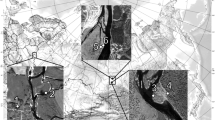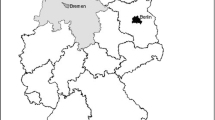Abstract
Purpose
The purpose of this study was to compare the distribution of the most significant medium and long-lived radioisotopes, i.e., 60Co, 137Cs, and 152Eu, in granulometric and organic fractions of alluvial soils downstream from the Krasnoyarsk Mining and Chemical Combine (KMCC), Russia, to reveal natural patterns of their behavior and accumulation.
Materials and methods
Soil samples collected at different elevations and depths in a floodplain of the Yenisey River downstream from the KMCC (20–250 km) were subjected to granulometric analysis by dry screening and a modified Petelin method. Fractions <0.05 mm were collected by a pipette method. Radionuclide activity in the different soil layers and in their fractions was determined using a spectrometer equipped with an HPGe detector. Concentration of total C (Ctot) and C of carbonates (Ccarb) was determined using a CHN analyzer before and after elimination of carbonates, organic C (Corg) being calculated as the difference between the obtained values. Organic fractions were separated by saturation of the air-dry sample with 0.1 M NaOH and further precipitation of humic acid from filtrate by 1 M HCl at pH 1. The separation resulted in three fractions of the fulvic acids, humic acids, and the residue containing the denuded mineral phase and the refractory organic residue. The selected bulk samples and fractions were analyzed for radionuclide activity.
Results and discussion
Based on earlier results, the distribution of the pelite (<0.01 mm) and aleurite (0.01–0.1 mm) fractions in alluvium and soil samples have been analyzed to evaluate the grain-size contribution to radionuclide fixation. A positive correlation between radionuclide activity and the portion of pelite fraction was established for 60Co and 152Eu, while 137Cs accumulation was not related with this fraction. In organic matter (OM) extracts, more than 90 % of 137Cs, at proportions similar to those attributable to 238Th and 40K, were associated with the residue fraction, while 72 % of 152Eu and 46 % of 60Co were found in the mobile fraction of the low molecular fulvic acids. In successive layers of the soil vertical profile, approximately 94 % of the 152Eu variation may be explained by a linear model with Corg and Ccarb values as independent variables.
Conclusions
Different associations of 137Cs, 60Co, and 152 Eu with particulate and organic fractions in river sediments and floodplain soils could be explained by the dominating discharge form (water soluble or particulate), affinity to organic substances of different mobility, sorption by minerals and their aggregates, and chemisorption.










Similar content being viewed by others
References
Bolsunovsky A (2011) Radionuclide speciation in sediments of the Yenisei River. Radioprotection 46(6):S195–S198
Bondareva L, Artamonova S (2011) The relationship of mineral and geochemical composition to artificial radionuclide partitioning in Yenisei river sediments downstream from mining-and-chemical combine Rosatom. Nat Sci 3(7):517–529
Bondareva LG, Bolsunovskii AY (2008) Speciation of artificial radionuclides 60Co, 137Cs, 152Eu, and 241Am in bottom sediments of the Yenisei River. Radiochemistry 50(5):547–552
Brown JE, Wright S, Linnik V (2002) STREAM. Source development and transport of radioactive contamination in the environment through the use of satellite imagery. Final Report (01.03.99-01.06.02). Project ERB IC-15-CT-98-0219 in the EC Inco-Copernicus Programme (IVth Framework). Statens stralevern, Oslo
Glaus MA, Hummel W, Van Loon LR (2000) Trace metal-humate interactions. I. Experimental determination of conditional stability constants. Appl Geochem 15(7):953–973
Korobova E, Linnik V, Chizhikova N (2008) The history of the Chernobyl 137Cs contamination of the flood plain soils and its relation to physical and chemical properties of the soil horizons (a case study). J Geochem Explor 96(2–3):236–255
Korobova EM, Linnik VG, Chizhikova NP, Alekseeva TN, Shkinev VM, Brown J, Dinu MI (2014) Granulometric and mineralogic investigation for explanation of radionuclide accumulation in different size fractions of the Yenisey floodplain soils. J Geochem Explor 142:49–59
Kropatcheva M, Chuguevsky A, Melgunov M (2012) Distribution of 152Eu and 154Eu in the alluvial soil–rhizosphere–plant roots’ system. J Environ Radioactiv 106:58–64
Linnik VG, Brown JE, Dowdall M, Potapov VN, Surkov VV, Korobova EM, Volosov AG, Vakulovsky SM, Tertyshnik EG (2005) Radioactive contamination of the Balchug (Upper Yenisey) floodplain, Russia in relation to sedimentation processes and geomorphology. Sci Total Environ 339:233–251
Linnik VG, Brown JE, Dowdall M, Potapov VN, Nosov AV, Surkov VV, Sokolov AV, Wright SM, Borghuis S (2006) Patterns and inventories of radioactive contamination of island sites of the Yenisey River, Russia. J Environ Radioactiv 87(2):188–208
Linnik VG, Korobova EM, Brown JE (2013) A historical outline of radionuclide contamination of the Yenisey floodplain based on landscape and radiometric survey. Geogr, Environ Sustain 2(6):49–62
Linnik VG, Korobova EM, Brown J, Surkov VV, Potapov VN, Sokolov AV (2014) Investigation of radionuclides in the Yenisey River floodplain systems: relation of the topsoil radionuclide contamination to landscape features. J Geochem Explor 142:60–68
Nosov AV (1997) A study of mechanism of migration of radioactive substances in the Yenisey floodplain. Russ Meteorol Hydrol 12:84–91 (in Russian)
Nosov AV, Krylov AV, Kiselev VP, Kazakov SV (2010) Modeling radionuclide migration in surface waters. Institute for Safe Development of Nuclear Energy. Rus. Ac. of Sci, Nauka, Moscow (in Russian)
Nossov AV, Martynova AM, Shishlov AE, Savitsky YV (2002) The analysis of radioactive contamination of the Yenisei River by results of expeditions for the period 1990–2000. In: Strand P, Jolle T (eds) Environmental radioactivity in the Arctic and Antarctic. The 5th International Conference. NRPA, Osteras, pp 167–170
Novikov AP (2010) Migration and concentration of artificial radionuclides in environmental objects. Geochem Int 48(13):1263–1387
Perel’man AI (1975) Landscape geochemistry. Vysshaya shkola, Moscow (in Russian)
Puffengoldz КN (1978) Geological glossary in 2 volumes. Nedra, Moscow (in Russian)
Sansone U, Belli B, Voitsekovitch OV, Kanivets VV (1996) 137Cs and 90Sr in water and suspended particulate matter of the Dnieper River-Reservoirs System (Ukraine). Sci Total Environ 186(3):257–271
Standring WJF, Brown JE, Dowdall M, Korobova EM, Linnik VG, Volosov AG (2009) Vertical distribution of anthropogenic radionuclides in cores from contaminated floodplains of the Yenisey River. J Environ Radioactiv 100(12):1109–1120
Sukhorukov FV, Melgunov MS, Kovalev SI (2000) The main traits of distribution of technogenous radionuclides in alluvial soils and bottom sediments of the Yenisei River. Contemp Probl Ecol 1:39–50 (in Russian)
Sukhorukov FV, Degermendzhy AG, Belolipetsky VM et al (2004) Distribution and migration of radionuclides in the Yenisei Plain. Publ. House of SB RAS “Geo”, in Russian
Sukhorukov FV, Melgunov MS, Makarova et al (2006) Mobility of technogenic radionuclides in soils and bottom sediments of the Yenisey river based on natural and laboratory experiments. In: Izrael Y (ed) Radioactivity after nuclear explosions and incidents. Proceedings of the International Conference. Gidrometeoizdat, St.-Pertersburg, pp 306–312, in Russian
Sval’nov VN, Alekseeva TN (2005) Granulometric analysis of the world ocean sediments. Nauka, Moscow (in Russian)
Vakulovsky SM, Nikitin AI, Chumichev VB, Katrich IY, Voitsekhovich OA, Medinets VI et al (1994) Cesium-137 and strontium-90 contamination of water bodies in the areas affected by releases from the Chernobyl nuclear power plant accident: an overview. J Environ Radioact 23:103–122
Vakulovsky SM, Tertyshnik EG, Borodina TS, Iskra AA (2006) Man-made radionuclides in the Yenisey River. In: Izrael Y (ed) Radioactivity after nuclear explosions and incidents, vol V. 2. Proceedings of the International Conference. Gidrometeoizdat, St.-Petersburg, pp 294–299, in Russian
Varshal GM (1994) Forms of migration of fulvic acids and metals in natural waters. Doctoral dissertation Vernadsky Institute of Geochemistry and Analytical Chemistry, Russian Academy of Sciences (in Russian)
Varshal GM, Koshcheeva IY, Velyukhanova TK, Chkhetia DN, Tyutyunnik OA, Grinevskaya ZM (1996) Sorption of heavy metals and isotopic carriers of long-lived radionuclides by humic acid: report 1. Sorption of caesium (I), strontium (II), cerium (III), ruthenium (IV) by humic acid. Geokhimiya 11:1107–1112 (in Russian)
Acknowledgments
The authors are grateful to Koshcheeva I.Ya., Chkhetia D.N., and Borisov A.P. for their help in organic fraction extraction and spectrometry of the samples. We thank the anonymous reviewers for their valuable comments and suggestions that helped to improve the text.
Author information
Authors and Affiliations
Corresponding author
Additional information
Responsible editor: Claudio Bini
Rights and permissions
About this article
Cite this article
Korobova, E.M., Linnik, V.G. & Brown, J. Distribution of artificial radioisotopes in granulometric and organic fractions of alluvial soils downstream from the Krasnoyarsk Mining and Chemical Combine (KMCC), Russia. J Soils Sediments 16, 1279–1287 (2016). https://doi.org/10.1007/s11368-015-1268-2
Received:
Accepted:
Published:
Issue Date:
DOI: https://doi.org/10.1007/s11368-015-1268-2




